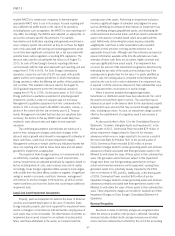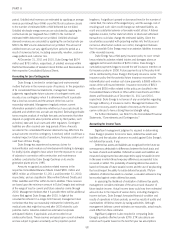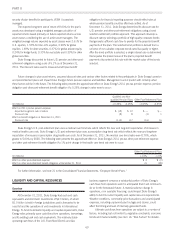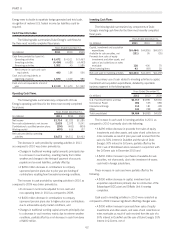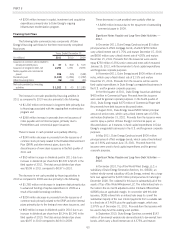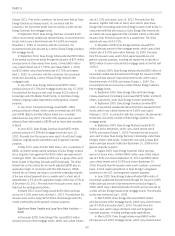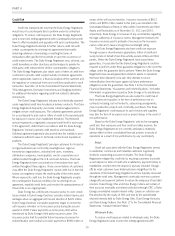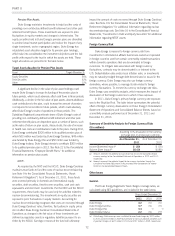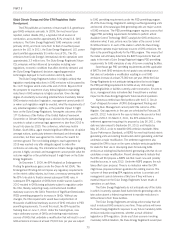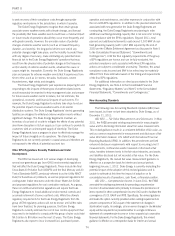Duke Energy 2011 Annual Report Download - page 86
Download and view the complete annual report
Please find page 86 of the 2011 Duke Energy annual report below. You can navigate through the pages in the report by either clicking on the pages listed below, or by using the keyword search tool below to find specific information within the annual report.
PART II
beyond applicable grace periods could result in accelerated due dates
and/or termination of the agreements. As of December 31, 2011,
Duke Energy was in compliance with all covenants related to its
significant debt agreements. In addition, some credit agreements may
allow for acceleration of payments or termination of the agreements
due to nonpayment, or to the acceleration of other significant
indebtedness of the borrower or some of its subsidiaries. None of the
debt or credit agreements contain material adverse change clauses.
Credit Ratings.
Duke Energy and certain subsidiaries each hold credit ratings by
Standard & Poor’s (S&P) and Moody’s Investors Service (Moody’s).
Duke Energy’s corporate credit rating and issuer credit rating from S&P
and Moody’s, respectively, as of February 1, 2012 is A- and Baa2,
respectively. The following table summarizes the February 1, 2012
unsecured credit ratings from the rating agencies retained by Duke
Energy and its principal funding subsidiaries.
Senior Unsecured Credit Ratings Summary as of February 1, 2012
Standard
and
Poor’s
Moody’s
Investors
Service
Duke Energy Corporation BBB+ Baa2
Duke Energy Carolinas, LLC A- A3
Duke Energy Ohio, Inc. A- Baa1
Duke Energy Indiana, Inc. A- Baa1
Duke Energy Kentucky, Inc. A- Baa1
Duke Energy’s credit ratings are dependent on, among other
factors, the ability to generate sufficient cash to fund capital and
investment expenditures and pay dividends on its common stock,
while maintaining the strength of its current balance sheet. If, as a
result of market conditions or other factors, Duke Energy is unable to
maintain its current balance sheet strength, or if its earnings and cash
flow outlook materially deteriorates, Duke Energy’s credit ratings could
be negatively impacted.
Credit-Related Clauses.
Duke Energy may be required to repay certain debt should the
credit ratings at Duke Energy Carolinas fall to a certain level at S&P or
Moody’s. As of December 31, 2011, Duke Energy had $2 million of
senior unsecured notes which mature serially through 2012 that may
be required to be repaid if Duke Energy Carolinas’ senior unsecured
debt ratings fall below BBB- at S&P or Baa3 at Moody’s, and $12
million of senior unsecured notes which mature serially through 2016
that may be required to be repaid if Duke Energy Carolinas’ senior
unsecured debt ratings fall below BBB at S&P or Baa2 at Moody’s.
Other Financing Matters.
At December 31, 2011, Duke Energy Carolinas had $400
million principal amount of 5.625% senior unsecured notes due
November 2012 classified as Current maturities of long-term debt on
Duke Energy Carolinas’ Consolidated Balance Sheets. At
December 31, 2010, these notes were classified as Long-term Debt
on Duke Energy Carolinas’ Consolidated Balance Sheets. Duke
Energy Carolinas currently anticipates satisfying this obligation with
proceeds from additional borrowings.
At December 31, 2011, Duke Energy Carolinas had $750
million principal amount of 6.25% senior unsecured notes due
January 2012 classified as Current maturities of long-term debt on
Duke Energy Carolinas’ Consolidated Balance Sheets. At December 31,
2010, these notes were classified as Long-term Debt on Duke Energy
Carolinas’ Consolidated Balance Sheets. As noted above, in January
2012, Duke Energy Carolinas satisfied this obligation with proceeds
from borrowings under the December 31, 2011 debt issuance.
At December 31, 2011, Duke Energy Ohio had $500 million
principal amount of 5.70% debentures due September 2012
classified as Current maturities of long-term debt on Duke Energy
Ohio’s Consolidated Balance Sheets. At December 31, 2010, these
notes were classified as Long-term Debt on Duke Energy Ohio’s
Consolidated Balance Sheets. Duke Energy Ohio currently anticipates
satisfying this obligation with proceeds from additional borrowings.
In April 2011, Duke Energy filed a registration statement (Form
S-3) with the SEC to sell up to $1 billion variable denomination
floating rate demand notes, called PremierNotes. The Form S-3 states
that no more than $500 million of the notes will be outstanding at
any particular time. The notes are offered on a continuous basis and
bear interest at a floating rate per annum determined by the Duke
Energy PremierNotes Committee, or its designee, on a weekly basis.
The interest rate payable on notes held by an investor may vary
based on the principal amount of the investment. The notes have no
stated maturity date, but may be redeemed in whole or in part by
Duke Energy at any time. The notes are non-transferable and may be
redeemed in whole or in part at the investor’s option. Proceeds from
the sale of the notes will be used for general corporate purposes. The
balance as of December 31, 2011, is $79 million. The notes reflect
a short-term debt obligation of Duke Energy and are reflected as
Notes payable on Duke Energy’s Consolidated Balance Sheets.
In September 2010, Duke Energy filed a Form S-3 with the SEC.
Under this Form S-3, which is uncapped, Duke Energy, Duke Energy
Carolinas, Duke Energy Ohio and Duke Energy Indiana may issue debt
and other securities in the future at amounts, prices and with terms to
be determined at the time of future offerings. The registration statement
also allows for the issuance of common stock by Duke Energy.
Duke Energy has paid quarterly cash dividends for 86
consecutive years and expects to continue its policy of paying regular
cash dividends in the future. There is no assurance as to the amount
of future dividends because they depend on future earnings, capital
requirements, financial condition and are subject to the discretion of
the Board of Directors.
Dividend and Other Funding Restrictions of Duke Energy
Subsidiaries.
As discussed in Note 4 to the Consolidated Financial Statements
“Regulatory Matters”, Duke Energy’s wholly-owned public utility
operating companies have restrictions on the amount of funds that
can be transferred to Duke Energy via dividend, advance or loan as a
result of conditions imposed by various regulators in conjunction with
Duke Energy’s merger with Cinergy. Additionally, certain other Duke
Energy subsidiaries have other restrictions, such as minimum
working capital and tangible net worth requirements pursuant to debt
and other agreements that limit the amount of funds that can be
transferred to Duke Energy. At December 31, 2011, the amount of
66



